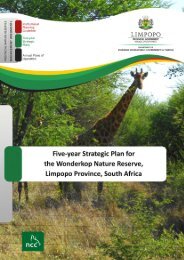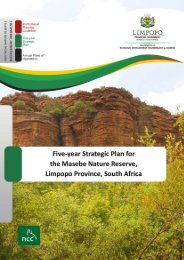Guiding principles for reserve management - NCC Environmental ...
Guiding principles for reserve management - NCC Environmental ...
Guiding principles for reserve management - NCC Environmental ...
- No tags were found...
You also want an ePaper? Increase the reach of your titles
YUMPU automatically turns print PDFs into web optimized ePapers that Google loves.
KEY RESERVE VALUES The <strong>reserve</strong> has the potential to demonstrate the efficacy, and benefits, of functionalpartnerships between the State and communal land owners in the collaborative administrationand <strong>management</strong> of provincial nature <strong>reserve</strong>s. The LNR <strong>for</strong>ms part of the Limpopo-Olifants System and is an important component of the theWolkberg Mountain Catchment Sub-system. Eight perrenial rivers, including the Selati,Makhutse and a number of tributaries of the Ngwabitsi Rivers, originate within the <strong>reserve</strong>. The <strong>reserve</strong> has an extremely rich historical background and a diverse cultural heritage. The abundant water sources arising in the <strong>reserve</strong> are of a high quality and are locally believedto have medicinal value. The <strong>reserve</strong> is characterised by an extremely broken topography and has exceptional scenicqualities. Its diverse landscape types include: steep escarpment cliffs; a high lying plateau; talussituated below the escarpment; foothills located under the talus; and plains (to a limitedextent). Several sinkholes, caves, blind valleys and tufa <strong>for</strong>mations add to this diversity. The <strong>reserve</strong> conserves significant biodiversity particularly with regard to its flora with at least 36plant species of conservation concern (including critically endangered species) found in the<strong>reserve</strong>. Leopards are also known to occur within the LNR and this species is classified as NearThreatened. The <strong>reserve</strong> is also noteworthy <strong>for</strong> its high abundance of butterfly species, many ofwhich are rare. The Legalameetse Nature Reserve <strong>for</strong>ms part of the registered Wolkberg Forest Belt ImportantBirding Area. Some of the bird species known to occur within the <strong>reserve</strong> include the NarinaTrogon and Cape Parrot. The <strong>reserve</strong> <strong>for</strong>ms part of Wolkberg/Bewaarskloof/Thabina Nature Reserve complex withexpansion and consolidation potential.3.3 The Reserve VisionThe vision of the <strong>reserve</strong> describes the overall long-term goal <strong>for</strong> the operation, protection anddevelopment of LNR. The following vision was developed by the RPT:VISIONWe see a collaborative partnership between the State and the relevantcommunities in the ongoing conservation and sustainable use of theLegalameetse Nature Reserve.From this partnership, we envisage securing: Meaningful and sustained benefits derived <strong>for</strong> the Mamashiane,Cypress, Mangena, Balloon, Madeira and Paris communities; Protection of the <strong>reserve</strong>’s outstanding scenic qualities; Preservation of the <strong>reserve</strong>’s unique historical ,cultural andarchaeological attributes; and Conservation of the biodiversity of the six vegetation units found in the<strong>reserve</strong>; and its associated fauna. Equitable access to, and responsible use of, the <strong>reserve</strong> and its naturalresources.Reserve Management Documents: Legalameetse Nature Reserve (Strategic Plan) 29

















